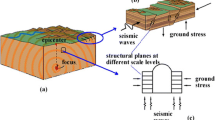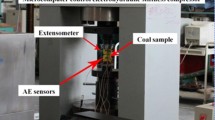Abstract
Seismic disturbances frequently trigger or induce violent strainbursts, threatening regular operations and personnel safety in deep underground excavation. We reproduce the cyclic disturbance-induced strainburst, i.e., the strainburst under combined high static stress and cyclic disturbance conditions in the laboratory using a true triaxial testing system with a relatively low stiffness, where the seismic disturbance is simulated by a low-frequency cyclic load. A damage evolution model that enhances the residual strain method is established to quantify the effects of various factors on the damage evolution of this type of strainburst. The energy budget over the development of the cyclic disturbance-induced strainburst is studied, and its energy criterion and magnitude of the kinetic energy release are also discussed. The damage evolution curve of the cyclic disturbance-induced strainburst is typically inverted S-shaped that is well represented by the inverse logistic function with three stages, i.e., initial stage, constant speed stage, and acceleration stage. It is found that the cyclic disturbance can significantly activate and accelerate rock damage, thus inducing a strainburst. The unique underlying reason is that most of the energy input by the cyclic disturbance is dissipated, which degrades the energy storage capacity and strength of the rock. This energy-based failure mechanism is collectively explained as the ‘rock degradation through energy dissipation’ due to the cyclic disturbance.













Similar content being viewed by others
Abbreviations
- \(\alpha ,\,\beta \;{\text{and}}\;\gamma\) :
-
Three factors that control the damage accumulation rates in different stages
- \(c_{s}\) :
-
Velocity of shear stress wave
- \(D\) :
-
Damage variable
- \(D_{0}\) :
-
Initial damage caused by static loading
- \(D_{{\text{C}}}\) :
-
Damage variable of the cyclic disturbance-induced strainburst
- \(\Delta \sigma\) :
-
Amplitude of the cyclic disturbance
- \(\Delta \sigma_{\max }^{{\text{d}}}\) :
-
Dynamic stress increment caused by a shear stress wave
- \(\varepsilon_{r}^{0}\) :
-
Residual strain caused by static loading
- \(\varepsilon_{r}^{n} \;{\text{and}}\;\varepsilon^{n}\) :
-
Residual and total strains after \(n\) cycles, respectively
- \(\varepsilon_{r}^{N} \;{\text{and}}\;\varepsilon^{N}\) :
-
Residual and total strains when a strainburst occurs, respectively
- \(E\) :
-
Young’s modulus of the rock
- \(E^{\prime}_{1}\) :
-
Unloading stiffness of the rock during cyclic disturbance
- \(E^{\prime}_{2}\) :
-
Unloading stiffness of the rock when a strainburst occurs
- \(f\) :
-
Frequency of the cyclic disturbance
- \(\rho\) :
-
Density of the rock
- \(p\) :
-
A parameter relating to cyclic disturbance frequency and amplitude
- \(PGV_{s}\) :
-
Peak ground velocity induced by a seismic event
- \(\sigma_{1} ,\;\sigma_{2} \;{\text{and}}\;\sigma_{3}\) :
-
The maximum, intermediate, and minimum principal stresses in a rock element
- \(\sigma_{x} ,\;\sigma_{y} ,\;{\text{and}}\;\sigma_{z}\) :
-
The intermediate, minimum, and maximum stresses acting on a rock element in potential rockburst volume in three coordinate directions
- \(\sigma_{d}\) :
-
The stress increment caused by seismic disturbance
- \(\sigma_{f}\) :
-
The stress at failure of a cyclic disturbance-induced strainburst
- \(\sigma_{\min }\) :
-
The lower limit stress of the cyclic disturbance
- \(\tau_{xy} ,\;\tau_{yz} \;{\text{and}}\;\tau_{zx}\) :
-
Shear stresses acting on a rock element in potential rockburst volume, respectively
- \(U_{{\text{D}}}\) :
-
Energy input by cyclic disturbance, and \(U_{{\text{D}}} \left( n \right)\) means energy input by cyclic disturbance after \(n\) cycles
- \(U_{{\text{E}}}\) :
-
Elastic strain energy stored in the sample, and there are other forms of \(U_{{\text{E}}} \left( \varepsilon \right)\), \({\kern 1pt} U_{{\text{E}}} \left( n \right){\kern 1pt} {\kern 1pt} {\kern 1pt}\), \(U_{{\text{E}}}^{{{\text{Post}}}}\), and \({\kern 1pt} {\kern 1pt} {\kern 1pt} {\kern 1pt} U_{{\text{E}}}^{{\text{r}}}\) when refers to specific states
- \(U_{{\text{F}}}\) :
-
Work done by the contact force between the machine and rock sample
- \(U_{{\text{K}}}\) :
-
Released kinetic energy of the ejected rock fragments
- \(U_{{\text{M}}}\) :
-
Elastic strain energy released by the experimental system
- \(U_{{\text{P}}}\) :
-
Dissipated energy, and there are other forms of \(U_{{\text{P}}} \left( \varepsilon \right)\), \(U_{{\text{P}}} \left( n \right)\), \({\kern 1pt} U_{{\text{P}}}^{{{\text{Post}}}}\), \(U_{{\text{P}}}^{1}\), and \(U_{{\text{P}}}^{2}\) when refers to specific states
- \(U_{{\text{S}}}\) :
-
Energy input by static loading
- \(U_{{{\text{SD}}}}\) :
-
Energy input by static loading and cyclic disturbance, and there are two other forms of \(U_{{{\text{SD}}}} \left( n \right)\) and \(U_{{{\text{SD}}}}^{{{\text{Post}}}}\)
References
Cai M (2013) Principles of rock support in burst-prone ground. Tunn Undergr Sp Tech 36(6):46–56
Cai M, Kaiser PK (2014) In-situ rock spalling strength near excavation boundaries. Rock Mech Rock Eng 47(2):659–675
Cai M, Kaiser PK (2018) Rockburst support reference book, Volume 1 Rockburst phenomenon and support characteristics. MIRARCO-mining innovation. Sudbury (Ontario, Canada): Laurentian University, Sudbury
Cook NGW (1965) A note on rockbursts considered as a problem of stability. J South Afr Int Min Metall 65(8):437–446
Diederichs MS (2007) The 2003 Canadian geotechnical colloquium: mechanistic interpretation and practical application of damage and spalling prediction criteria for deep tunnelling. Can Geotech J 44(9):1082–1116
Du K, Tao M, Li XB, Zhou J (2016) Experimental study of slabbing and rockburst induced by true-triaxial unloading and local dynamic disturbance. Rock Mech Rock Eng 49(9):3437–3453
Feng XT, Chen BR, Feng GL, Zhou ZN, Zheng H (2018) Description of rockbursts in tunnels. In: Feng XT (ed) Rockburst: mechanisms, monitoring, warning and mitigation. Butterworth-Heinemann, Oxford, pp 3–19
Ge XR, Jiang Y, Lu YD, Ren JX (2003) Testing study on fatigue deformation law of rock under cyclic loading. Chin J Rock Mech Eng 22(10):1581–1585 (in Chinese)
Gong QM, Yin LJ, Wu SY, Zhao J, Ting Y (2012) Rock burst and slabbing failure and its influence on TBM excavation at headrace tunnels in Jinping II hydropower station. Eng Geol 124(1):98–108
Hauquin T, Gunzburger Y, Deck O (2018) Predicting pillar burst by an explicit modelling of kinetic energy. Int J Rock Mech Min Sci 107:159–171
He MC, Xia HM, Jia XN, Gong WL, Zhao F, Liang KY (2012) Studies on classification, criteria and control of rockbursts. J Rock Mech Geotech Eng 4(2):97–114
He MC, Sousa LRE, Miranda T, Zhu GL (2015) Rockburst laboratory tests database—application of data mining techniques. Eng Geol 185:116–130
He J, Dou LM, Gong SY, Li J, Ma ZQ (2017) Rock burst assessment and prediction by dynamic and static stress analysis based on micro-seismic monitoring. Int J Rock Mech Min Sci 93:46–53
Hu LH, Ma K, Liang X, Tang CA, Wang ZW, Yan LB (2018) Experimental and numerical study on rockburst triggered by tangential weak cyclic dynamic disturbance under true triaxial conditions. Tunn Undergr Sp Tech 81:602–618
Hu LH, Su GS, Liang X, Li YC, Yan LB (2020) A distinct element based two-stage-structural model for investigation of the development process and failure mechanism of strainburst. Comput Geotech 118:103333. https://doi.org/10.1016/j.compgeo.2019.103333
Jiang Q, Feng XT, Xiang TB, Su GS (2010) Rockburst characteristics and numerical simulation based on a new energy index: a case study of a tunnel at 2,500 m depth. Bull Eng Geol Environ 69(3):381–388
Jiang JQ, Su GS, Zhang XH, Feng XT (2020) Effect of initial damage on remotely triggered rockburst in granite: an experimental study. Bull Eng Geol Environ. https://doi.org/10.1007/s10064-020-01760-8
Jin JF, Li XB, Qiu C, Tao W, Zhou XJ (2014) Evolution model for damage accumulation of rock under cyclic impact loadings and effect of static loads on damage evolution. Chin J Rock Mech Eng 33(8):1662–1671 (in Chinese)
Kaiser PK, Yazici S, Maloney S (2001) Mining-induced stress change and consequences of stress path on excavation stability—a case study. Int J Rock Mech Min Sci 38(2):167–180
Li XB, Weng L (2016) Numerical investigation on fracturing behaviors of deep-buried opening under dynamic disturbance. Tunn Undergr Sp Tech 54:61–72
Li XB, Zhou ZL, Lok TS, Hong L, Yin TB (2008a) Innovative testing technique of rock subjected to coupled static and dynamic loads. Int J Rock Mech Min Sci 45(5):739–748
Li XB, Zhou ZL, Ye ZY, Ma CD, Zhao FJ, Zuo YJ, Hong L (2008b) Study of rock mechanical characteristics under coupled static and dynamic loads. Chin J Rock Mech Eng 27(7):1387–1395 (in Chinese)
Li ZL, Dou LM, Wang GF, Cai W, He J, Ding YL (2015) Risk evaluation of rock burst through theory of static and dynamic stresses superposition. J Cent South Univ 22(2):676–683
Li XB, Gong FQ, Tao M, Dong LJ, Du K, Ma CD, Zhou ZL, Yin TB (2017) Failure mechanism and coupled static-dynamic loading theory in deep hard rock mining: a review. J Rock Mech Geotech Eng 9(4):767–782
Li Y, Sun S, Tang C (2019) Analytical prediction of the shear behaviour of rock joints with quantified waviness and unevenness through wavelet analysis. Rock Mech Rock Eng 52(10):3645–3657. https://doi.org/10.1007/s00603-019-01817-5
Li Y, Tang C, Li D, Wu C (2020) A new shear strength criterion of three-dimensional rock joints. Rock Mech Rock Eng 53:1477–1483. https://doi.org/10.1007/s00603-019-01976-5
Manouchehrian A, Cai M (2016) Simulation of unstable rock failure under unloading conditions. Can Geotech J 53:22–34
Ortlepp W, Stacey T (1994) Rockburst mechanisms in tunnels and shafts. Tunn Undergr Sp Tech 9(1):59–65
Su GS, Feng XT, Wang JH, Jiang JQ, Hu LH (2017a) Experimental study of remotely triggered rockburst induced by a tunnel axial dynamic disturbance under true-triaxial conditions. Rock Mech Rock Eng 50(8):2207–2226
Su GS, Hu LH, Feng XT, Yan LB, Zhang GL, Yan SZ, Zhao B, Yan ZF (2017b) True triaxial experimental study of rockbursts induced by ramp and cyclic dynamic disturbances. Rock Mech Rock Eng 51(4):1027–1045
Su GS, Jiang JQ, Zhai SB, Zhang GL (2017c) Influence of tunnel axis stress on strainburst: an experimental study. Rock Mech Rock Eng 50(6):1551–1567
Su GS, Zhai SB, Jiang JQ, Zhang GL, Yan LB (2017d) Influence of radial stress gradient on strainbursts: an experimental study. Rock Mech Rock Eng 50(10):2659–2676
Tarasov BG, Stacey TR (2017) Features of the energy balance and fragmentation mechanisms at spontaneous failure of class I and class II rocks. Rock Mech Rock Eng 50(10):2563–2584
Verhulst PF (1838) Notice sur la loi que la population suit dans son accroissement. Corresp Math et Phys 10:113–121 (In French)
Xiao JQ, Ding DX, Jiang FL, Xu G (2010) Fatigue damage variable and evolution of rock subjected to cyclic loading. Int J Rock Mech Min Sci 47(3):461–468
Xu YH, Cai M (2017) Influence of loading system stiffness on post-peak stress–strain curve of stable rock failures. Rock Mech Rock Eng 50(9):2255–2275
Xu J, Jiang JD, Xu N, Liu QS, Gao YF (2017) A new energy index for evaluating the tendency of rockburst and its engineering application. Eng Geol 230:46–54
Zhang CQ, Feng XT, Zhou H, Qiu SL, Wu WP (2012) Case histories of four extremely intense rockbursts in deep tunnels. Rock Mech Rock Eng 45(3):275–288
Zhao XG, Wang J, Cai M, Cheng C, Ma LK, Su R, Zhao F, Li DJ (2014) Influence of unloading rate on the strainburst characteristics of Beishan granite under true-triaxial unloading conditions. Rock Mech Rock Eng 47(2):467–483
Zhou J, Li X, Mitri HS (2018) Evaluation method of rockburst: state-of-the-art literature review. Tunn Undergr Sp Tech 81:632–659
Zhu WC, Li ZH, Zhu L, Tang CA (2010) Numerical simulation on rockburst of underground opening triggered by dynamic disturbance. Tunn Undergr Sp Tech 25(5):587–599
Zuo YJ, Li XB, Zhou ZL, Ma CD, Zhang YP, Wang WH (2005) Damage and failure rule of rock undergoing uniaxial compressive load and dynamic load. J Cent South Univ Technol 12(6):742–748
Acknowledgements
The authors thank the financial supports from the National Natural Science Foundation (Grant No. 51809033), the National Key Research and Development Plan (Grant No. 2018YFC1505301), and the Fundamental Research Funds for the Central Universities (Grant No. DUT20LK15).
Author information
Authors and Affiliations
Corresponding author
Ethics declarations
Conflict of interest
The authors declare they have no conflicts of interest to this work.
Additional information
Publisher's Note
Springer Nature remains neutral with regard to jurisdictional claims in published maps and institutional affiliations.
Rights and permissions
About this article
Cite this article
Hu, L., Li, Y., Liang, X. et al. Rock Damage and Energy Balance of Strainbursts Induced by Low Frequency Seismic Disturbance at High Static Stress. Rock Mech Rock Eng 53, 4857–4872 (2020). https://doi.org/10.1007/s00603-020-02197-x
Received:
Accepted:
Published:
Issue Date:
DOI: https://doi.org/10.1007/s00603-020-02197-x




